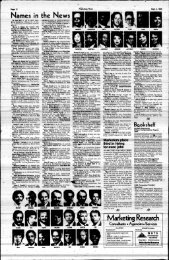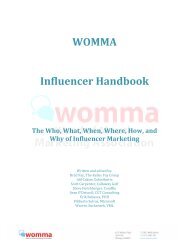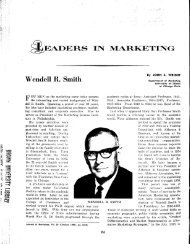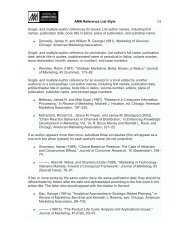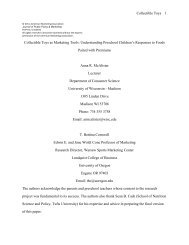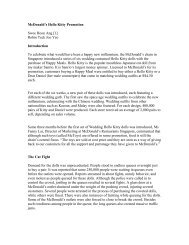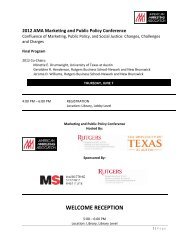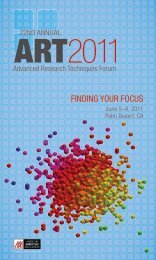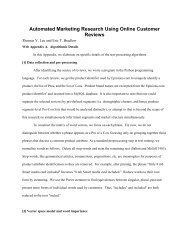ROP Color and Its Effect on Newspaper Advertising - American ...
ROP Color and Its Effect on Newspaper Advertising - American ...
ROP Color and Its Effect on Newspaper Advertising - American ...
You also want an ePaper? Increase the reach of your titles
YUMPU automatically turns print PDFs into web optimized ePapers that Google loves.
68<br />
<str<strong>on</strong>g>ROP</str<strong>on</strong>g> <str<strong>on</strong>g>Color</str<strong>on</strong>g> <str<strong>on</strong>g>and</str<strong>on</strong>g> <str<strong>on</strong>g>Its</str<strong>on</strong>g> <str<strong>on</strong>g>Effect</str<strong>on</strong>g> <strong>on</strong> <strong>Newspaper</strong><br />
<strong>Advertising</strong><br />
BURLEIGH B. GARDNER<br />
<str<strong>on</strong>g>and</str<strong>on</strong>g><br />
YEHUDI A. COHEN*<br />
y The auth<strong>on</strong> report a riudy of reacti<strong>on</strong>s to four department store ads, two with color <str<strong>on</strong>g>and</str<strong>on</strong>g> two black<br />
<str<strong>on</strong>g>and</str<strong>on</strong>g> whit*. The adi with color evoked more positive reacti<strong>on</strong>s to the merch<str<strong>on</strong>g>and</str<strong>on</strong>g>ise <str<strong>on</strong>g>and</str<strong>on</strong>g> were more often<br />
identified with higher status stores.<br />
In recent years, improvements in color printing have<br />
made it possible for newspapers to offer run-of-press<br />
color to advertisers. As the quality of the color printing<br />
has improved, advertisers have been attracted by possibilities<br />
but the additi<strong>on</strong>al cost has made them hesitate.<br />
Furthermore, even at its best, the color reproducti<strong>on</strong> <strong>on</strong><br />
newsprint has been poor compared to that seen in<br />
magazines with coated stock. As a result, there has<br />
been a c<strong>on</strong>siderable amount of research directed to the<br />
questi<strong>on</strong> of whether <str<strong>on</strong>g>ROP</str<strong>on</strong>g> color c<strong>on</strong>tributes to the effectiveness<br />
of the ad.<br />
One of the most comprehensive studies was c<strong>on</strong>ducted<br />
by the Milwaukee Jottmal in 1957. It used split<br />
runs, that is, every other copy of the paper carried an<br />
ad in color, with the same ad in black <str<strong>on</strong>g>and</str<strong>on</strong>g> white appearing<br />
in the alternate copies. Using the Starch technique,<br />
it tested claimed recall the day after the ads appeared<br />
<str<strong>on</strong>g>and</str<strong>on</strong>g> then five days later. The results showed both increased<br />
readership <str<strong>on</strong>g>and</str<strong>on</strong>g> increased retenti<strong>on</strong> of color compared<br />
to black <str<strong>on</strong>g>and</str<strong>on</strong>g> white [1].<br />
As part of a series of studies investigating color in<br />
both newspapers <str<strong>on</strong>g>and</str<strong>on</strong>g> magazines. Social Research, Inc.<br />
tried to answer these questi<strong>on</strong>s:<br />
1. Does the additi<strong>on</strong> of color significantly change the<br />
reacti<strong>on</strong> to an ad?<br />
2. Is this change favorable to the advertiser?<br />
To explore these questi<strong>on</strong>s, a variety of techniques<br />
were used to measure both the rati<strong>on</strong>al evaluati<strong>on</strong> of<br />
the ad, or product, <str<strong>on</strong>g>and</str<strong>on</strong>g> the emoti<strong>on</strong>al reacti<strong>on</strong>s which<br />
would infiuence feelings toward the product. This article<br />
reports <strong>on</strong> <strong>on</strong>e special study of technical interest <str<strong>on</strong>g>and</str<strong>on</strong>g><br />
<strong>on</strong>e also quite dramatic in its results.<br />
* Burieigh Gardner is presi(fent of Sodal Research. Mr.<br />
Cohoi is a research associate with the same organizatkm. The<br />
authcHS want to thank dw Chicago Daily News <str<strong>on</strong>g>and</str<strong>on</strong>g> 6» CMcago<br />
Sun-Times for permissi<strong>on</strong> to publish ttiese findings.<br />
THE STUDY<br />
By chance a single issue of the Chicago Daily News<br />
c<strong>on</strong>tained four ads for women's <str<strong>on</strong>g>and</str<strong>on</strong>g> girls' coats. Two of<br />
the ads showed coats in color (both a bright shade of<br />
red), <str<strong>on</strong>g>and</str<strong>on</strong>g> two were in black <str<strong>on</strong>g>and</str<strong>on</strong>g> white. The black <str<strong>on</strong>g>and</str<strong>on</strong>g><br />
white ads were by high status stores <str<strong>on</strong>g>and</str<strong>on</strong>g> the color ads<br />
by lower status stores. We used this opportunity to test<br />
reacti<strong>on</strong>s to color in similar but not identical ads <str<strong>on</strong>g>and</str<strong>on</strong>g> for<br />
similar merch<str<strong>on</strong>g>and</str<strong>on</strong>g>ise, despite the unavoidable possibility<br />
of interacti<strong>on</strong> between store status <str<strong>on</strong>g>and</str<strong>on</strong>g> use of color.<br />
With these ads the following questi<strong>on</strong>s were explored:<br />
1. Will women feel that the coats in color are more<br />
desirable than those in black <str<strong>on</strong>g>and</str<strong>on</strong>g> white?<br />
2. Will tbe coats from the higher status stores be more<br />
attractive <str<strong>on</strong>g>and</str<strong>on</strong>g> desirable than those from the lower<br />
status stores?<br />
3. Will the use of color affect the status evaluati<strong>on</strong> of<br />
those stores?<br />
A two-stage study with a simple open-end discussi<strong>on</strong><br />
questioimaire was used with women in their homes. In<br />
the first stage the women went through a copy of the<br />
paper <str<strong>on</strong>g>and</str<strong>on</strong>g> looked at the ads. In the sec<strong>on</strong>d stage the<br />
names of the stores <str<strong>on</strong>g>and</str<strong>on</strong>g> other identifying details were<br />
masked. This gave <strong>on</strong>e set of interviews in which the<br />
name of the store was apparent <str<strong>on</strong>g>and</str<strong>on</strong>g> <strong>on</strong>e set without the<br />
infiuence of the names.<br />
The order of viewing was reversed in alternate interviews<br />
to reduce possible bias due to order of exposure;<br />
that is, <strong>on</strong>e woman would he asked to go througji the<br />
paper from fr<strong>on</strong>t to back <str<strong>on</strong>g>and</str<strong>on</strong>g> the next woman would<br />
go through it from back to fr<strong>on</strong>t. Since the black <str<strong>on</strong>g>and</str<strong>on</strong>g><br />
white ads appeared before the color ads, this alternated<br />
the exposure to black-\^te first <str<strong>on</strong>g>and</str<strong>on</strong>g> color first.<br />
This test differed from split-nm tests or portfolio tests<br />
in several r^pects. In split-run tests, si^j«:ts are exposed<br />
to the ad as it normally appears in the paper.<br />
However, each versi<strong>on</strong> (rf an ad is e:qx>sed to diffoent<br />
subjects. In portfolio tests subjects are customarily<br />
shown die ads mounted in a portfolio—not as tbey<br />
normally appear in tia i»W8papn.
THE EFFECT OF <str<strong>on</strong>g>ROP</str<strong>on</strong>g> COLOR NEWSPAPER ADVBITISING 69<br />
This test was intermediate between the two techniques<br />
since the ads were in their actual newspaper<br />
setting <str<strong>on</strong>g>and</str<strong>on</strong>g> the women were asked to discuss the ad<br />
as they went throi^ the newspaper. This approximates<br />
the way they normally read ads.<br />
The following interview guide was used:<br />
"There are several ads for Fall coats <str<strong>on</strong>g>and</str<strong>on</strong>g> suits, especially<br />
for college giils, in this paper. I'd like you to<br />
go through the paper <str<strong>on</strong>g>and</str<strong>on</strong>g> look at the ads, pretending<br />
you are planning to go shopping with some girl or<br />
young woman. As you look at these ads, tell me which<br />
items seem most attractive <str<strong>on</strong>g>and</str<strong>on</strong>g> which items seem least<br />
attractive."<br />
"Of these four ads, which <strong>on</strong>e do you like the best?<br />
Why that <strong>on</strong>e?"<br />
In the sec<strong>on</strong>d versi<strong>on</strong> of this study three questi<strong>on</strong>s<br />
were added, as follows:<br />
"If you were thinking of buying a coat or a suit in<br />
which of these stores would you expect to find something<br />
that you would like? Why?"<br />
"In which would you least expect to find something?<br />
Why?"<br />
"For each of the four ads which store do you think<br />
that the ad is from? If you d<strong>on</strong>'t know just guess."<br />
The sample characteristics for each stage are shown<br />
in Table 1.<br />
Age<br />
20-29<br />
30-39<br />
40-49<br />
50-55<br />
Total<br />
Social class<br />
Upper middle<br />
Lower middle<br />
Upper lower<br />
Total<br />
Table I<br />
CHARACTERISTICS OF SAMPLE MEMBERS<br />
Educati<strong>on</strong>al level<br />
Less than high school graduate<br />
High school graduate<br />
Some college or college graduate<br />
Total<br />
Stage 1<br />
24<br />
30<br />
19<br />
3<br />
76<br />
17<br />
35<br />
24<br />
76<br />
N<br />
II<br />
37<br />
28<br />
76<br />
Stage II<br />
36<br />
34<br />
26<br />
10<br />
106<br />
17<br />
44<br />
45<br />
(06<br />
N<br />
12<br />
62<br />
32<br />
With these data we could examine both the ratings of<br />
the stores <str<strong>on</strong>g>and</str<strong>on</strong>g> ads <str<strong>on</strong>g>and</str<strong>on</strong>g> the qualitative t<strong>on</strong>e of the way<br />
the wcmen talked about the ads.<br />
THE FINDINGS<br />
The rraults can be summarized as follows:<br />
106<br />
<str<strong>on</strong>g>Color</str<strong>on</strong>g> increases status. Am<strong>on</strong>g the women shown the<br />
ads with the stores names blocked out, 79, or 74 percent<br />
expressed preference for the color ads. When asked to<br />
name the stores <strong>on</strong>ly, 13 percent correctiy identified<br />
the store with the color ads. Of the balance, 70 percent<br />
attributed the color ads to high status stores.<br />
<str<strong>on</strong>g>Color</str<strong>on</strong>g> makes the merch<str<strong>on</strong>g>and</str<strong>on</strong>g>ise <str<strong>on</strong>g>and</str<strong>on</strong>g> the ad more interesting<br />
<str<strong>on</strong>g>and</str<strong>on</strong>g> attractive. This is shown in the comments<br />
about the ads <str<strong>on</strong>g>and</str<strong>on</strong>g> in the preference rating.<br />
In the comments, the women generally used words<br />
expressing excitement, attracti<strong>on</strong>, <str<strong>on</strong>g>and</str<strong>on</strong>g> feelings, such<br />
as love, like, beautiful, smart, exciting, etc. In c<strong>on</strong>trast,<br />
such words rarely appeared in the comments <strong>on</strong><br />
the black <str<strong>on</strong>g>and</str<strong>on</strong>g> white ads. These differences are illustrated<br />
by the following remarks:<br />
"I like the A ad. I think the color strikes you. You<br />
are more apt to notice it because of the color. B is<br />
the same, <strong>on</strong>ly it's not a full page. If the X ad was in<br />
color this would be a great ad. I like the A for color but<br />
X for the layout."<br />
"Price means a lot to girls going to college whether<br />
you want to admit it or not. Of all the ads, the Y <strong>on</strong>e<br />
seems to bear this out. If it were in color, of course, it<br />
would be much more colorful."<br />
"Gee! That's a nice coat. It's almost the nicest ad<br />
I have seen. I like the color—^it's nice. I like this<br />
color ad—it makes me feel good. ... If the other<br />
two ads are in color, why isn't X's?"<br />
"I remember seeing this ad. At the time, I thou^t<br />
it was a most attractive ad. The color is most attractive.<br />
It is a good ad. I like it <str<strong>on</strong>g>and</str<strong>on</strong>g>, you know, I d<strong>on</strong>'t know<br />
why I like it. This (A) is a nice ad, too. I like the<br />
color. It is a truly good ad. ... You know, after the<br />
first two ads, this <strong>on</strong>e (X) is a let-down. ... I am<br />
sure this (Y) is a good ad. However, if it were in<br />
color, it would be terrific."<br />
"I like that <strong>on</strong>e. I like the style <str<strong>on</strong>g>and</str<strong>on</strong>g> I like the color.<br />
The red attracts me but it could be in any other color<br />
<str<strong>on</strong>g>and</str<strong>on</strong>g> be attractive."<br />
"It's different. The color is different <str<strong>on</strong>g>and</str<strong>on</strong>g> the color<br />
is helpful in the ad. <str<strong>on</strong>g>Color</str<strong>on</strong>g> is always helpful. ... I<br />
d<strong>on</strong>'t like the Y ad particularly. It leaves too much to<br />
the imaginati<strong>on</strong> <str<strong>on</strong>g>and</str<strong>on</strong>g> you have to suppose its true<br />
color. After the color ads, I did not like it."<br />
"The X ad is good but somewhat of a let-down after<br />
the two previous ads in color."<br />
When asked to name the ads they liked <str<strong>on</strong>g>and</str<strong>on</strong>g> disliked<br />
(without knowing the name of the stores) the<br />
color ads were most preferred, as shown in Figure 1<br />
<strong>on</strong> page 70.<br />
<str<strong>on</strong>g>Color</str<strong>on</strong>g> <str<strong>on</strong>g>and</str<strong>on</strong>g> status interact to influence liking for the<br />
ad, though the use of color appears to be a dominant<br />
factor. When the names of the stores were known, the<br />
black <str<strong>on</strong>g>and</str<strong>on</strong>g> white ads for the higher status stores were<br />
rated somewhat better than when the stores were unknown.<br />
However, when the names of the stores were<br />
not known, preference for the color ads was appredably<br />
higher than when the names of the stores were known.
70 JOUMMAL W AAAMCETMG RBEARCH, AAAY 1964<br />
Prefer<br />
color ads<br />
Knew name of store (N = 76) 54 percent<br />
IMd not know name of store (N = 106) 74 percent<br />
Figure I<br />
PERCENTAGES OF WOMEN UKING ADVERTISEMENT WHEN<br />
ADVERTISER WAS KNOWN AND NOT KNOWN<br />
HIGH<br />
STATUS<br />
STORES<br />
BLACK<br />
AND<br />
WHITE<br />
ADS<br />
LOW<br />
STATUS<br />
STORES<br />
COLOR<br />
ADS<br />
AD 1<br />
AD 2<br />
AD 3<br />
AD4<br />
mmm1<br />
ADVERTISER NOT KNOWN<br />
w<br />
10 20 30<br />
PERCENT<br />
J ADVERTISER<br />
Y/mmm.<br />
KNOWN<br />
40 50<br />
CONCLUSIONS<br />
This study goes b^<strong>on</strong>d i»evioiis recall stiuiies in<br />
ezpkning the kinds ressi<strong>on</strong>s of interest in actually sraing<br />
them.<br />
These findings are c<strong>on</strong>sistent with some tests <strong>on</strong><br />
food advertising, which suggests that there may be<br />
some general princq>les involved. But it is dearly<br />
risky to draw general c<strong>on</strong>clusi<strong>on</strong>s in this area from <strong>on</strong>ly<br />
a few tests. Reacti<strong>on</strong>s to symbolic materials are so<br />
complex that <strong>on</strong>ly after many experiments can we<br />
claim to have established any principles. At this stage<br />
we can be certain that color does make a difference<br />
in reacti<strong>on</strong> to an ad. We are accumulating evidence<br />
that this difference is often favorable to the purpose<br />
of the advertiser, <str<strong>on</strong>g>and</str<strong>on</strong>g> a next step is to investigate the<br />
extent to which this difference is translated into buying<br />
behavior.<br />
REFERENCE<br />
1. Colo<str<strong>on</strong>g>ROP</str<strong>on</strong>g>tics, Milwaukee: The Milwaukee Joumal, 1957.



